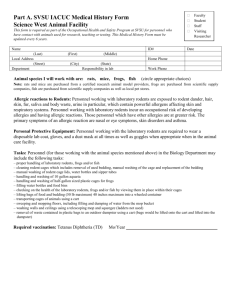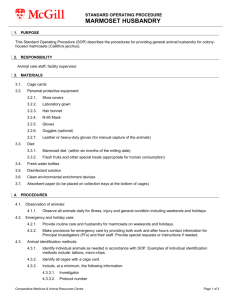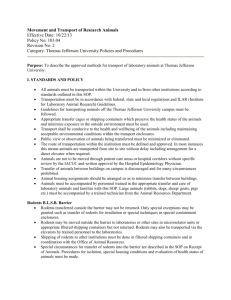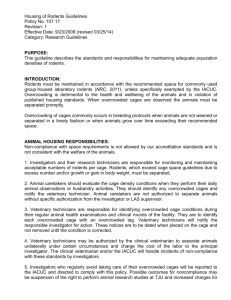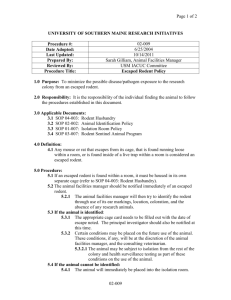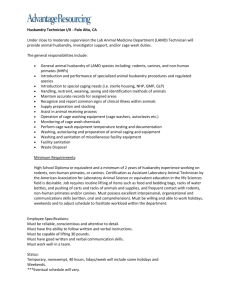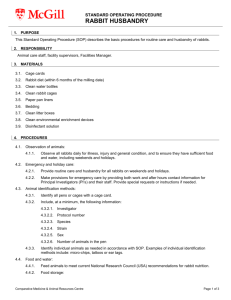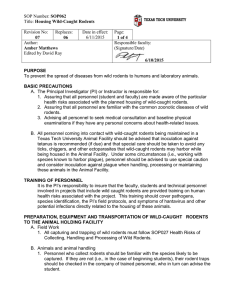3. materials - McGill University
advertisement
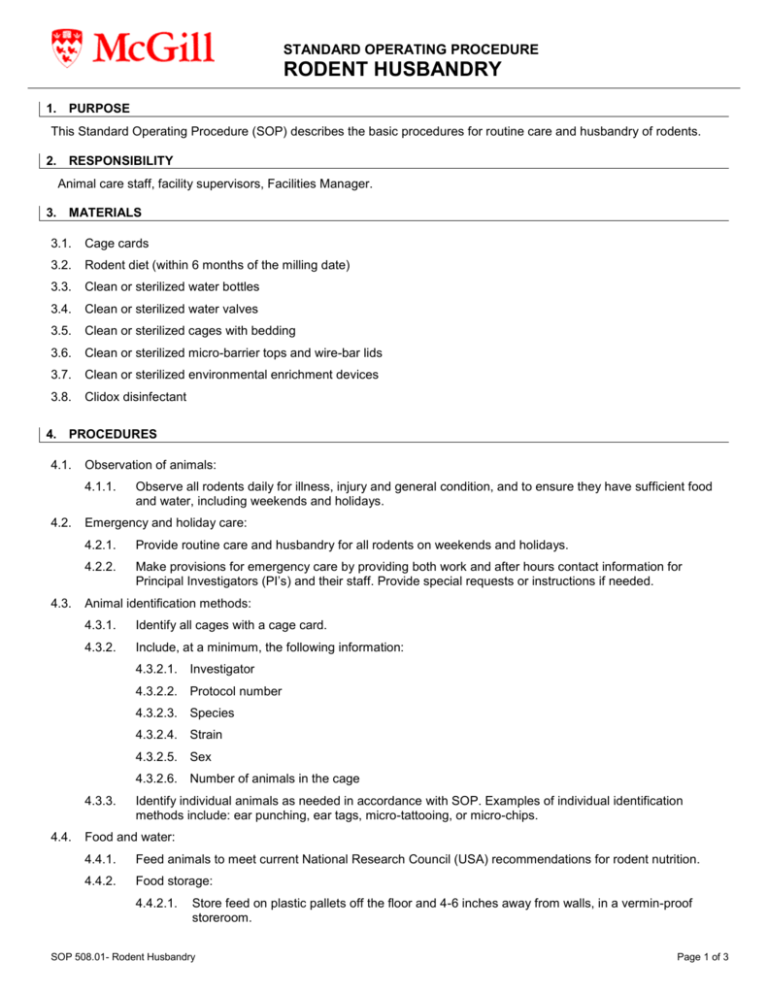
STANDARD OPERATING PROCEDURE RODENT HUSBANDRY 1. PURPOSE This Standard Operating Procedure (SOP) describes the basic procedures for routine care and husbandry of rodents. 2. RESPONSIBILITY Animal care staff, facility supervisors, Facilities Manager. 3. MATERIALS 3.1. Cage cards 3.2. Rodent diet (within 6 months of the milling date) 3.3. Clean or sterilized water bottles 3.4. Clean or sterilized water valves 3.5. Clean or sterilized cages with bedding 3.6. Clean or sterilized micro-barrier tops and wire-bar lids 3.7. Clean or sterilized environmental enrichment devices 3.8. Clidox disinfectant 4. PROCEDURES 4.1. Observation of animals: 4.1.1. 4.2. 4.3. Observe all rodents daily for illness, injury and general condition, and to ensure they have sufficient food and water, including weekends and holidays. Emergency and holiday care: 4.2.1. Provide routine care and husbandry for all rodents on weekends and holidays. 4.2.2. Make provisions for emergency care by providing both work and after hours contact information for Principal Investigators (PI’s) and their staff. Provide special requests or instructions if needed. Animal identification methods: 4.3.1. Identify all cages with a cage card. 4.3.2. Include, at a minimum, the following information: 4.3.2.1. Investigator 4.3.2.2. Protocol number 4.3.2.3. Species 4.3.2.4. Strain 4.3.2.5. Sex 4.3.2.6. Number of animals in the cage 4.3.3. 4.4. Identify individual animals as needed in accordance with SOP. Examples of individual identification methods include: ear punching, ear tags, micro-tattooing, or micro-chips. Food and water: 4.4.1. Feed animals to meet current National Research Council (USA) recommendations for rodent nutrition. 4.4.2. Food storage: 4.4.2.1. Store feed on plastic pallets off the floor and 4-6 inches away from walls, in a vermin-proof storeroom. SOP 508.01- Rodent Husbandry Page 1 of 3 4.4.2.2. Store open feed bags in leak-proof containers with tightly fitting lids. 4.4.2.3. Maintain temperature and humidity controls in the storeroom. Avoid temperatures above 21°C and extremes in humidity. Use feed within 6 months of milling date. 4.4.2.4. Stack feed in a manner that allows easy reading of the milling date. 4.5. 4.6. 4.7. 4.8. 4.9. 4.4.3. Check automatic watering devices daily for proper operation and cleanliness. 4.4.4. Replace empty bottles with clean ones rather than refilling them. 4.4.5. Monitor water quality routinely to ensure that it is free of contaminants that could potentially expose animals to chemical or infectious agents. Refer to SOP for water quality monitoring requirements. Breeding program: 4.5.1. House breeders in monogamous pairs, trios or harem groups. 4.5.2. Remove the pregnant female from the harem group and put her in her own cage before giving birth. 4.5.3. Wean litters before the next litter is born to prevent over-crowding in the cage. Social and environmental enrichment: 4.6.1. Group-house rodents whenever possible. 4.6.2. Provide environmental enrichment devices for all rodents. 4.6.3. Examples of enrichment include, but are not limited to, the following: cellulose-based shelters, PVC pipe, Nestlets®, corn husks, autoclaved blocks of wood, Nylabones®. Please refer to Environmental Enrichment SOPs. Quarantine procedures: 4.7.1. Quarantine rodents from unapproved vendors for up to eight weeks depending on the status of both the vendor and the facility where they will be housed. The veterinarian will determine the quarantine requirements for each shipment. Refer to SOP. 4.7.2. Quarantine of rodents from approved vendors is not required. Euthanasia and disposal of dead animals: 4.8.1. Euthanize rodents by CO2 inhalation or overdose of anesthetics. Refer to SOP. 4.8.2. Ensure that euthanasia is conducted by trained and experienced staff. 4.8.3. Dispose of dead animals by incineration. Vermin control 4.9.1. Refer to SOP for a description of the vermin control program. 4.10. Environment and environmental control: 4.10.1. Maintain room temperatures between 18 and 24° C. 4.10.2. Maintain relative humidity between 30% and 70%. 4.10.3. Maintain a daily log of room temperature and humidity. 4.11. Bedding: 4.11.1. Use wood chips, shredded paper products or chopped corn cobs as bedding materials. 4.11.2. Use enough bedding to keep the rodents clean and dry until the next scheduled change. Note: Cedar shavings are not recommended due to the harmful presence of aromatic hydrocarbons. 4.12. Lighting: 4.12.1. Provide a regular diurnal lighting cycle. Note: Lights are controlled by timers set at a photoperiod of 12 to 14 hours of light. Check the timer performance routinely. SOP 508.01- Rodent Husbandry Page 2 of 3 4.13. Space requirements: 4.13.1. Provide cages that are appropriate in size for the number of rodents housed in them. Refer to CCAC recommendations. 4.14. Cleaning of cages: 4.14.1. Change ventilated cages once every two weeks and static cages once every week, at a minimum. 4.14.2. Change cages more frequently if needed to keep the animals clean and dry and provide a healthy environment. 4.14.3. Supply fresh bedding with each cage change with the exception of the sentinel cages. Please refer to SOP. 4.15. Cleaning and sanitation of housing room and equipment: 4.15.1. 4.15.2. 4.15.3. Weekly: 4.15.1.1. Flush the floor drains. 4.15.1.2. Change/clean prefilters in changing stations/biosafety cabinets 4.15.1.3. Check light timers. 4.15.1.4. Mop floors. Monthly: 4.15.2.1. Change the micro-isolator tops. 4.15.2.1. Wipe down all surfaces such as sinks, doors, door jams and doorknobs, windows, cart tops, shelves, etc. with the disinfectant solution. 4.15.2.2. Clean changing stations/biosafety cabinets: remove filters, vacuum and drain. 4.15.2.3. Clean room exhaust grills. Bi-annually: 4.15.3.1. Wash all walls with disinfectant solution. 4.15.3.2. Wash racks. 4.16. Transportation: 4.16.1. Transport rodents being shipped outside of McGill University in filtered commercial rodent transport boxes. 4.16.2. Transport rodents within McGill University in either filter cages or unfiltered cages wrapped in a material which prevents animal allergens from escaping into the environment. Cages needed to be covered by opaque material. Refer to SOP. 4.17. Preparation of disinfecting solution: 4.17.1. Wear personal protective equipment when preparing and using disinfectant solution. 4.17.2. Dilute according to manufacturer’s recommendation. 4.17.3. Clean surfaces prior to disinfection to remove any organic material. 4.17.4. Apply disinfectant and allow for adequate contact time. 4.18. Waste Management: 4.18.1. Deposit non-regulated or non-infectious Medical Waste and soiled materials in dumpsters. 4.18.2. Regulated or infectious Medical Waste is processed by McGill University’s Waste Management program. 5. SAFETY 5.1. Working with rodents can trigger related allergies. Check with the facility supervisor regarding requirements for personal protective equipment and refer to SOP. 5.2. Observe SOP for animal related injury. Comparative Medicine & Animal Resources Centre Page 3 of 3 Written by: Jim Gourdon Revised on (yy-mm-dd): 08-12-22 SOP 508.01- Rodent Husbandry Revision # 01 Effective date (yy-mm-dd): 08-11-24
